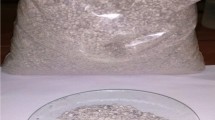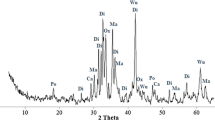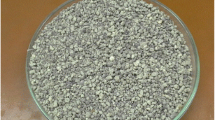Abstract
Mineral carbonation of industrial byproducts is a promising carbon capture and storage technique to abate global warming. Steelmaking slag is the main byproduct of the steelmaking industry, and it is a potential source of alkaline oxides which can be transformed into carbonates. The carbonation of the steelmaking slag has proven to be a great countermeasure to sequester significant amounts of CO2 emitted from the steelmaking process at the point sources while offering the environmental benefits of waste reduction. In this study, a supercritical carbonation process is developed to sequester CO2 using steelmaking slag. Compared with conventional aqueous carbonation, this process has several advantages including higher reactivity, less waste generation, and better economic feasibility. A response surface methodology is utilized to assess the effect of operating parameters on carbonation efficiency and to optimize the process. Under the optimum conditions, the maximum CO2 uptake of 213 gCO2/kgSlag is achieved. We believe that the findings of this study would help enable efficient CO2 mitigation utilizing an efficient and environmentally sustainable process and thereby contribute to carbon neutrality and waste reduction.
Access provided by Autonomous University of Puebla. Download conference paper PDF
Similar content being viewed by others
Keywords
- Supercritical carbonation
- Steelmaking slag
- Mineral carbonation
- Process optimization
- Response surface methodology
Introduction
Iron and steel are essential materials that enable a modern way of life filled with buildings, automobiles, and bridges. Steelmaking slag is the main byproduct of the steel industry and is a potential source of alkaline oxides which can be transformed into carbonates [1, 2]. In 2019, world iron slag production was estimated to be between 320 and 384 million tons, with steel slag production estimated to be between 190 to 280 million tons [3]. Of all steel slags produced globally, about 14% are landfilled [4]. The main reasons behind the partial utilization of steel slags are their volume instability and their leaching behavior [5].
The carbonation of steelmaking slag can offer the benefits of improving the volume stability of the slag and producing enhanced construction materials with better inertness and corrosion resistance. Furthermore, considerable amounts of CO2 emitted from the steelmaking industry can be sequestered at the point sources via steelmaking slag carbonation, and in turn, abating global warming. The steelmaking industry generated 1.85 tons of CO2 for one ton of steel produced in 2018, and it accounts for 7–9% of the direct CO2 emissions from global fossil fuel use [6]. To this end, the carbonation of slag has come to the fore as a breakthrough technique to mitigate the CO2 gas emissions resulting from the steelmaking industry.
In this study, a supercritical carbonation process of steelmaking slag was developed for CO2 sequestration. A response surface methodology was used to quantify the effect of four operating parameters, i.e., slag particle size, CO2 pressure, reaction temperature, and water-to-slag ratio, on the carbonation efficiency and to optimize the process. The main contributor to enhance the carbonation efficiency was revealed, and the maximum CO2 uptake was obtained under the optimum conditions.
Experimental
Materials
The steelmaking slag was obtained from an undisclosed source. Glass vials were supplied from VWR (USA). The liquid CO2 tank was purchased from Messer Canada Inc. (Canada). Hydrochloric acid (36.5–38.0 vol.% assays) and nitric acid (68.0–70.0 wt% assays) were purchased from VWR. Milli-Q Integral water purification system (MilliporeSigma, Germany) was used to produce deionized water (0.055 µS/cm). A certified standard stock solution of iron, calcium, magnesium, silicon, manganese, aluminum, and chromium (1000 mg/L) was purchased from Inorganic Ventures, Inc. (USA) and used for calibration of the analytical instrument.
Experimental Procedure
For the supercritical carbonation of EAF slag, the EAF slag samples with different particle sizes were prepared using a jaw crusher (BB 200 Jaw Crusher, Retsch GmbH, Germany), ball mill (roll lab ball mill, The Galigher Co., USA), and ro-tap (RX-29 ro-tap, W.S. Tyler, USA). Afterward, the dried slag sample with a certain particle size was thoroughly mixed with water at different water-to-slag ratios. The glass vials containing the mixture of the slag sample and water were placed in an autoclave reactor (Parr 4560 mini-benchtop reactor-600 mL, Parr Instrument Company, USA). Next, the reactor was sealed and heated to a set temperature (ramp-up time of 30 min). In the meantime, the pressure reached a setpoint utilizing a supercritical CO2 pump (GB40-CO2, Dongguan Usun Fluid Control Equipment Co., Ltd., China) and air compressor. The reaction time was maintained constant at 48 h, and no agitation was made. After the test was completed, the carbonated slag sample was dried at 80 ºC for > 24 h and analyzed by different characterization techniques.
Factorial Design of Experiments and Empirical Model Building
A systematic study was carried out to investigate the effect of operating parameters, namely slag particle size (X1), CO2 pressure (X2), reaction temperature (X3), and water-to-slag ratio (X4), on the CO2 uptake. The primary and quadratic effects of one factor, alongside the second-order interactions between two factors, were quantitatively analyzed. Each parameter was coded to five levels (−2, −1, 0, +1, +2) to directly compare the effect of different parameters. Upper and lower limits of factor levels were determined on the basis of the preliminary experimental results and the operating ranges of comparable processes in the literature [7,8,9,10]. Table 1 shows the detailed information of operating parameters.
A response surface methodology was used to design the experiments and to build an empirical model. The experimental data were then fitted to the empirical model Eq. (1) using multiple linear least squares regression (mLLSR, Eq. (2)).
where \(\widehat{\beta }\) is the vector including each of the model parameters, β0 corresponds to the baseline bias, β1 corresponds to X1 (slag particle size), β2 corresponds to X2 (CO2 pressure), β3 corresponds to X3 (reaction temperature), β4 corresponds to X4 (water-to-slag ratio), βij corresponds to the second-order interaction of the two different factors, and \({\widehat{\beta }}_{ii}\) corresponds to the quadratic term.
where X is the experimental design matrix and Y is the response matrix including the actual response (measured CO2 uptake).
Morphological, Mineralogical, and Compositional Characterization
The inorganic carbon analysis (IC, SSM-5000A, Shimadzu, Japan) was carried out to calculate the CO2 uptake of the solid sample. The compositional characterization was performed using alkali fusion digestion (Claisse LeNeo, Malvern Panalytical, UK; Li2B4O7 49.75 wt%, LiBO2 49.75 wt%, LiBr 0.50 wt%). The concentration of elements of interest (Fe, Ca, Mg, Si, Mn, Al, and Cr) in the solution was measured using inductively coupled plasma optical emission spectroscopy (ICP-OES, Optima 8000, PerkinElmer, USA).
Results and Discussion
Characterization of Steelmaking Slag
The elemental composition of the steelmaking slag was analyzed using alkali fusion followed by ICP-OES. As shown in Table 2, the steelmaking slag consists of 23.0 wt% iron, 15.3 wt% calcium, 6.4 wt% magnesium, 5.6 wt% silicon, 5.4 wt% manganese, 2.5 wt% aluminum, and 1.9 wt% chromium. The mineralogical characteristics of the slag were investigated with XRD in our previous work, and it was found that the slag is mainly composed of larnite (Ca2SiO4), brownmillerite (Ca2((Fe1.63Al0.37)O5), magnesioferrite (Fe2MgO4), wustite (Fe0.944O), and hematite (Fe2O3) [11].
Effect of Operating Parameters and Empirical Model Building
A series of supercritical carbonation experiments was conducted based on the experimental matrix designed using a response surface methodology. The effect of operating parameters on the extrinsic CO2 uptake was investigated, and the empirical model was built using multiple linear least squares regression (mLLSR). Figure 1 presents the ordered factor effect coefficients with enough significance (α = 0.05) on the extrinsic CO2 uptake of the steelmaking slag.
As can be seen in Fig. 1, the slag particle size (X1) showed the most significant positive impact on the CO2 uptake. This is understandable because the decrease of slag particle size increases the total surface area and carbonated volume of the slag particles, and in turn, the carbonation efficiency.
The CO2 uptake was also positively affected by the CO2 pressure (X2). To explain this phenomenon, the thermodynamic modeling of the CaCO3-MgCO3-CO2-H2O system was conducted. The detailed explanations of the modeling procedure and results are presented in the authors’ previous work [11]. The results showed that the concentration of dissolved CO2 dramatically increases with increasing the partial pressure of CO2. Because the equilibria of the overall carbonation reaction are governed by the concentration of dissolved CO2 (Reaction (3)), this increase results in the increase of the carbonation efficiency.
The positive effect of the water-to-slag ratio (X4) was captured because water participates in the CO2 dissolution and dissociation reactions and is significantly consumed for producing silicic acid, which is a product of the carbonation reaction (Reaction (3)).
Optimization of the Supercritical Carbonation Process
Based on the factor effect coefficients (Fig. 1), the empirical model for the CO2 uptake was built as presented in Eq. (4).
The supercritical carbonation process was then optimized using the ExcelSolver software with the objective of maximizing the CO2 uptake in 48 h processing time. The conditions that satisfy this scenario were slag particle size of -105 + 74 µm, CO2 pressure of 101.4 bar, temperature of 69.5 °C, and water-to-slag ratio of 0.444 mL/gslag. Under these conditions, 189.0 ± 19.8 gCO2/kg of the extrinsic CO2 uptake was experimentally achieved, validating the high model accuracy (absolute relative deviation = 3.40%). Considering the intrinsic CO2 uptake of the steelmaking slag, this slag proves to sequester a maximum of 213.4 gCO2/kg via supercritical carbonation.
Conclusions
The current study is focused on developing a supercritical carbonation process of steelmaking slag to sequester CO2. A systematic investigation was performed using a response surface methodology to study the effect of operating parameters, i.e., slag particle size, CO2 pressure, reaction temperature, and water-to-slag ratio, on the carbonation efficiency of the steelmaking slag. On the basis of the results, the slag particle size was found to have the most significant positive impact on the CO2 uptake. After the process optimization, the optimum operating conditions were determined to be slag particle size of -105 + 74 µm, CO2 pressure of 101.4 bar, temperature of 69.5 °C, and water-to-slag ratio of 0.444 mL/gslag, which resulted in 189.0 ± 19.8 gCO2/kg extrinsic carbonation efficiency in 48 h processing time. The results of this study ascertain that the developed process offers several advantages including high carbonation efficiency, no use of chemicals, and minimal volumes of waste. It is expected that the findings of this study help enable the carbon sequestration using industrial wastes, in particular, steelmaking slag, thereby contributing to carbon neutrality and sustainable recycling.
References
Ghosh A, Chatterjee A (2008) Ironmaking and steelmaking: Theory and practice, 1st ed. PHI Learning Private Limited, New Delhi
Zhang J, Matsuura H, Tsukihashi F (2014) Processes for Recycling. Elsevier Ltd, Amsterdam
U.S. Geological Survey (2020) Mineral commodity summaries 2020: U.S. geological survey, 200p
Branca TA, Colla V, Algermissen D et al (2020) Reuse and recycling of by-products in the steel sector: recent achievements paving the way to circular economy and industrial symbiosis in Europe. Metals (Basel) 10:345. https://doi.org/10.3390/met10030345
Fisher LV, Barron AR (2019) The recycling and reuse of steelmaking slags—a review. Resour Conserv Recycl 146:244–255. https://doi.org/10.1016/j.resconrec.2019.03.010
World Steel Association (2020) Steel’s contribution to a low carbon future and climate resilient societies, 6p
Fernández-Carrasco L, Rius J, Miravitlles C (2008) Supercritical carbonation of calcium aluminate cement. Cem Concr Res 38:1033–1037. https://doi.org/10.1016/j.cemconres.2008.02.013
Min Y, Jun YS (2018) Wollastonite carbonation in water-bearing supercritical CO2: Effects of water saturation conditions, temperature, and pressure. Chem Geol 483:239–246. https://doi.org/10.1016/j.chemgeo.2018.01.012
Urbonas L, Leno V, Heinz D (2016) Effect of carbonation in supercritical CO2 on the properties of hardened cement paste of different alkalinity. Constr Build Mater 123:704–711. https://doi.org/10.1016/j.conbuildmat.2016.07.040
Sugama T, Ecker L, Butcher T (2010) Carbonation of rock minerals by supercritical carbon dioxide at 250 °C, 23p
Kim J, Azimi G (2021) The CO2 sequestration by supercritical carbonation of electric arc furnace slag. J CO2 Util 52:1–11. https://doi.org/10.1016/j.jcou.2021.101667
Author information
Authors and Affiliations
Corresponding author
Editor information
Editors and Affiliations
Rights and permissions
Copyright information
© 2022 The Minerals, Metals & Materials Society
About this paper
Cite this paper
Kim, J., Azimi, G. (2022). Supercritical Carbonation of Steelmaking Slag for the CO2 Sequestration. In: Lazou, A., Daehn, K., Fleuriault, C., Gökelma, M., Olivetti, E., Meskers, C. (eds) REWAS 2022: Developing Tomorrow’s Technical Cycles (Volume I). The Minerals, Metals & Materials Series. Springer, Cham. https://doi.org/10.1007/978-3-030-92563-5_59
Download citation
DOI: https://doi.org/10.1007/978-3-030-92563-5_59
Published:
Publisher Name: Springer, Cham
Print ISBN: 978-3-030-92562-8
Online ISBN: 978-3-030-92563-5
eBook Packages: Chemistry and Materials ScienceChemistry and Material Science (R0)





